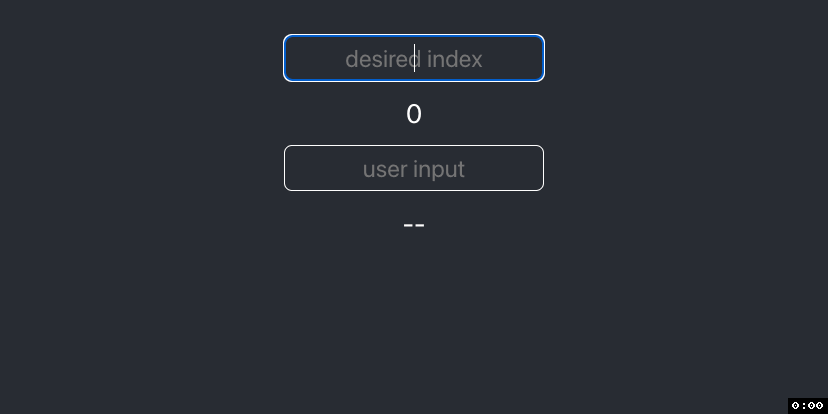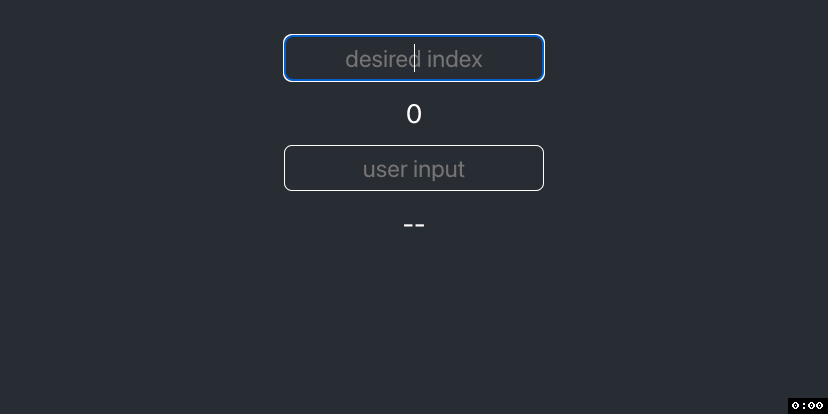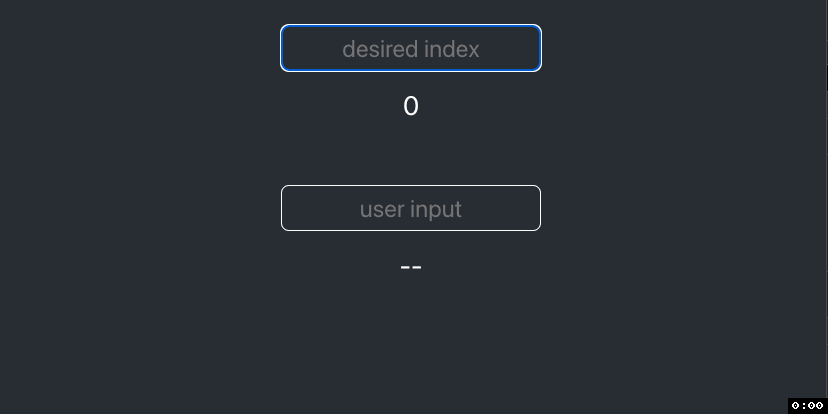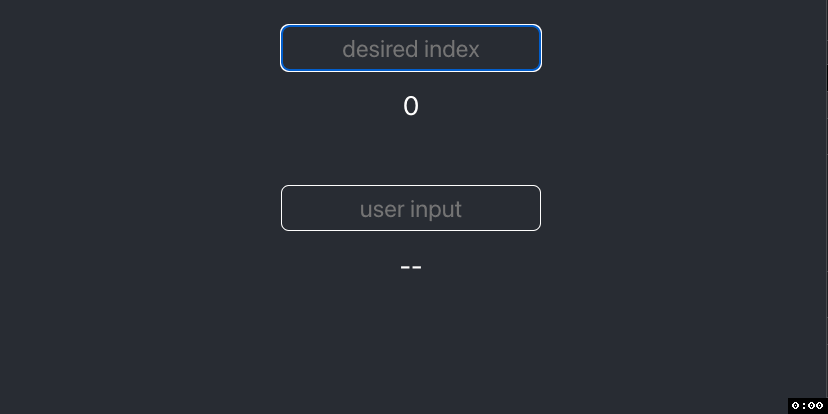In this article, we will explore when and how to use React's useMemo Hook to
increase your app's performance.
Buckle up and strap in. This article is on the heavier side for both theory and
length.
If you'd like, you can skim this as a
Medium
or dev.to
article.
fork and clonecd clientnpm inpm start
We'll begin with a quick overview of our starter code. In App.js, you'll find
a function name "jacobsthal," two pieces of state, and a variable named
"calculation". Notice we wrapped jacobsthal in a useCallback Hook, and
calculation is the returned value from calling jacobsthal.
The JSX renders both inputs and their respective values. If you need a refresher
on what service the useCallback Hook provides, I'd suggest you pause here and
give my
useCallback
article a quick read.
import './App.css';
import { useState, useCallback } from 'react';
function App() {
const [number, setNumber] = useState('');
const [input, setInput] = useState('');
const jacobsthal = useCallback(n => {
if (n < 2) return n;
return jacobsthal(n - 1) + 2 * jacobsthal(n - 2);
}, []);
const calculation = jacobsthal(number);
return (
<div>
<main>
<section>
<div className='user-input'>
<input
type='text'
value={number}
placeholder='desired index'
onChange={e => {
setNumber(e.target.value);
}}
/>
</div>
<div className='result'>{calculation || 0}</div>
</section>
<section>
<div className='user-input'>
<input
type='text'
value={input}
placeholder='user input'
onChange={e => {
setInput(e.target.value);
}}
/>
</div>
<div className='result'>{input || '--'}</div>
</section>
</main>
</div>
);
}
export default App;Ourjacobsthalfunction is a simple, recursive function that returns the Jacobsthal Number at a given index. The specifics of the code and Jacobsthal Number don't matter foruseMemo. All we care about is that it's defined within our component, hence the implementation ofuseCallback, and that it's computationally expensive.
If we provide a small value to the number input, our React app behaves as
expected, snappily rendering the result. However, as we increase the value of
our input, while the app still provides the desired output, it takes
increasingly longer to render.
Thirty-five will be our test case because it is slow enough to be annoying but still testable. So we'll type 35 and wait for the output to calculate.
Now start typing into the second input. See how slow it is to render? That's because when the input changed, the entire component re-rendered, and our expensive function recalculated the output before re-rendering, even though our output didn't change.
This is obviously a problem.
A Quick Aside:Junior Developers make this mistake far too often. You don't always need
useStatefor your forms. I'll even propose that you usually don't. If no part of your application needs to see the real-time value, like when submitting a form to an API, you should be usinguseRefinstead. We will get into how and why in a later article.
So with the stage set and the curtains drawn, how do we resolve the issue at hand?
Memoization is a Programming technique that stores the results of a function call, so the next time you call that function, it doesn't have to recalculate the output. Instead, it can return the stored result, saving time complexity with recursive functions.
That's all you need to know for now, but if you'd like a more in-depth
explanation, check out this
Memoization in JavaScript
article by GeeksforGeeks. And at the end of this article, we will refactor our
jacobsthal function to implement proper JavaScript memoization.
To sum it up, useCallback stores the definition of the function, so it
doesn't unnecessarily redefine every render. useCallback creates
referential equality between instances of the function across renders.
Similarly, useMemo stores the result of the function call, so it doesn't
unnecessarily recalculate every render. useMemo creates referential
equality between instances of the value across renders.
You can already see how this is helpful and leads directly to the primary
purpose of useMemeo. In short, the aptly named useMemo Hook is React's
built-in memoization tool.
Let's write some code!
We'll start by importing useMemo from 'react'.
import { useState, useCallback, useMemo } from 'react';You guessed it, useMemo has a similar syntactical skeleton to both useEffect
and useCallback: an anonymous callback function with a dependency array that
tracks a variable to tell our Hook when to trigger.
useEffect = (() => {}, []);
useCallback = (() => {}, []);
useMemo = (() => {}, []);As in our useCallback example, we want to cache what's returned from this
Hook. So we will assign our calculation variable to the return value of
useMemo, wrapping our function call in an anonymous callback.
Remember to return the result of your function call so it is accessible by
useMemo!
const calculation = useMemo(() => {
return jacobsthal(number);
}, []);After we save, we'll notice a familiar warning from React. Our Hook is missing a dependency.
WARNING in [eslint]
src/App.js
Line 11:6: React Hook useMemo has a missing dependency: 'number'. Either include it or remove the dependency array react-Hooks/exhaustive-deps
webpack compiled with 1 warning
Before blindly obeying React's warnings, let's first think through the purpose of this dependency array and the functionality it extends to our application.
The intent of dependency arrays with React Hooks is to trigger our Hook more
intentionally and specifically. When the value of the variable being tracked
changes, the Hook knows it's time to do its thing.
In our specific case, when number changes, we want our jacobsthal function
to recalculate the result.
So let's add number to our dependency array.
const calculation = useMemo(() => {
return jacobsthal(number);
}, [number]);Now that we've memoized our function, let's test it out. We'll start by
typing 35. Our calculation still takes time because our jacobsthal function is
still computationally expensive. But now, when we type in the second input, our
React app is again snappy and responsive. It's no longer recalculating our
jacobsthal output because number has not changed.
Because we memoized the results of our function, we've created referential equality and eliminated any unnecessary renders, making our React app more performant.
If you only came here for the React piece, thanks so much for reading, and look
out for the useRef article next!
But what to do about our computationally expensive jacobsthal function? Time
to refactor.
We begin by creating a previousValues parameter with a default value of an
empty array. This will be our cache that we will later pass to our recursive
sequence. Doing so will spare our recursive sequence from working overtime.
export const jacobsthal = (n, previousValues = []) => {
if (n < 2) {
return n;
}
return jacobsthal(n - 1) + 2 * jacobsthal(n - 2);
};Next, inside our code block, we'll create a results variable. We will later
reassign the value, so we'll need to use our let keyword.
export const jacobsthal = (n, previousValues = []) => {
let result;
if (n < 2) {
return n;
}
return jacobsthal(n - 1) + 2 * jacobsthal(n - 2);
};Instead of returning our computations directly, we'll explicitly wrap our
recursive sequence in an else block and assign our return options to
result.
export const jacobsthal = (n, previousValues = []) => {
let result;
if (n < 2) {
result = n;
} else {
result = jacobsthal(n - 1) + 2 * jacobsthal(n - 2);
}
};Now, after our conditionals have evaluated and assigned a value to result, we
set previousValues at index n equal to our current result, then return
result, thus caching this value and making it accessible as a return.
export const jacobsthal = (n, previousValues = []) => {
let result;
if (n < 2) {
result = n;
} else {
result = jacobsthal(n - 1) + 2 * jacobsthal(n - 2);
}
previousValues[n] = result;
return result;
};Next, the first thing our function should do is check to see if previousValues
at index n exists. If it does, we return it.
export const jacobsthal = (n, previousValues = []) => {
if (previousValues[n]) {
return previousValues[n];
}
let result;
if (n < 2) {
result = n;
} else {
result = jacobsthal(n - 1) + 2 * jacobsthal(n - 2);
}
previousValues[n] = result;
return result;
};Lastly, we'll pass previousValues as an argument to our recursive sequence.
export const jacobsthal = (n, previousValues = []) => {
if (previousValues[n]) {
return previousValues[n];
}
let result;
if (n < 2) {
result = n;
} else {
result =
jacobsthal(n - 1, previousValues) + 2 * jacobsthal(n - 2, previousValues);
}
previousValues[n] = result;
return result;
};Whew. We can now test our newly (and thoroughly) memoized component. Try 35
again. Pretty snappy, huh? So snappy, in fact, that if we enter 1026 as our
input, it's still responsive. Even calculating 'Infinity' doesn't crash our
app. And yes, useMemo is still doing its thing.
There is no lag in our other input.
If you'd like to dive deeper with useMemo, you can learn more in the official React docs.
I’m always looking for new friends and colleagues. If you found this article helpful and would like to connect, you can find me at any of my homes on the web.
GitHub | Twitter | LinkedIn | Website | Medium | Dev.to




